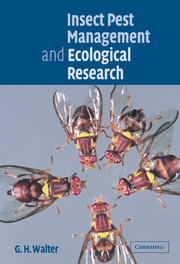Book contents
- Frontmatter
- Contents
- Preface
- Acknowledgements
- 1 Introduction
- Part 1 The place and nature of insect ecology research for IPM
- Part 2 Specific directions in insect ecology research for IPM
- 6 Understanding species: good taxonomy, sexual species and pest management
- 7 Polyphagous pests, parasitoids and predators: trophic relations, ecology and management implications
- 8 Pre-release evaluation and selection of natural enemies: population and community criteria
- 9 Autecological research on pests and natural enemies
- Part 3 Synopsis: Ecological research for IPM today
- References
- Index
8 - Pre-release evaluation and selection of natural enemies: population and community criteria
Published online by Cambridge University Press: 22 August 2009
- Frontmatter
- Contents
- Preface
- Acknowledgements
- 1 Introduction
- Part 1 The place and nature of insect ecology research for IPM
- Part 2 Specific directions in insect ecology research for IPM
- 6 Understanding species: good taxonomy, sexual species and pest management
- 7 Polyphagous pests, parasitoids and predators: trophic relations, ecology and management implications
- 8 Pre-release evaluation and selection of natural enemies: population and community criteria
- 9 Autecological research on pests and natural enemies
- Part 3 Synopsis: Ecological research for IPM today
- References
- Index
Summary
Biological pest control … is considered to be an art by many scientists, although several efforts have been made to transfer it to the realm of science. A number of researchers (the scientists) defend a more scientific basis of pest control, others (the artists) do not mind too much about theoretical considerations, because they think that this scientific basis is still too small and they develop biological pest control mainly by trial-and-error methods.
j. c. van lenteren (1980, p. 369)Introduction
Biological control has had many remarkable successes since a ‘classical’ introduction saved the Californian citrus industry from the ravages of cottony cushion scale at the end of the nineteenth century (Caltagirone & Doutt, 1989; Doutt, 1958; van Driesche & Bellows, 1996). The technique has since been developed and extensively deployed, often with good economic return (e.g. DeBach & Rosen, 1991; Greathead, 1986, 1994). The rationale that underpins biocontrol is the impression that many species in their native environment are limited in numbers primarily by consumers, whether predators, parasitoids, pathogens or herbivores, and which are called ‘natural enemies’ or, within the biocontrol context, ‘beneficial species’ (van Driesche & Bellows, 1996). Biocontrol is therefore aimed at restoring the original dynamic, usually in situations in which the pest species has invaded a new area without its natural enemies. The aim is not to exterminate pests, but to maintain them at lower non-pestiferous densities.
- Type
- Chapter
- Information
- Insect Pest Management and Ecological Research , pp. 207 - 234Publisher: Cambridge University PressPrint publication year: 2003



